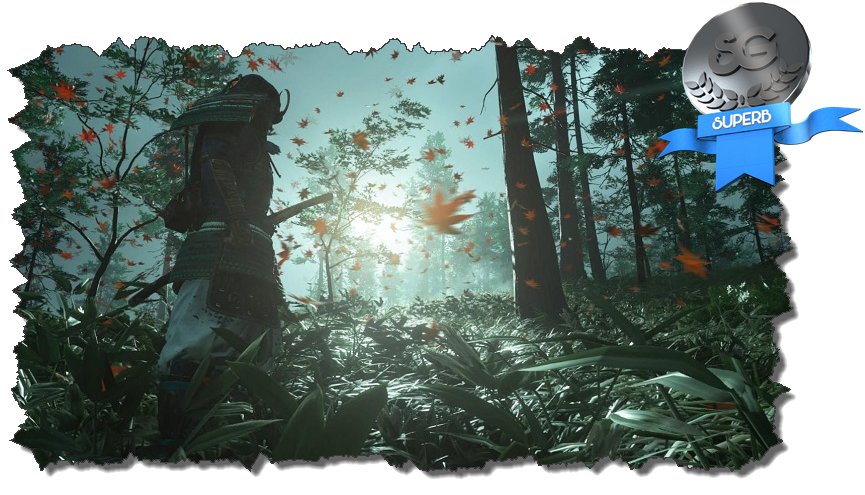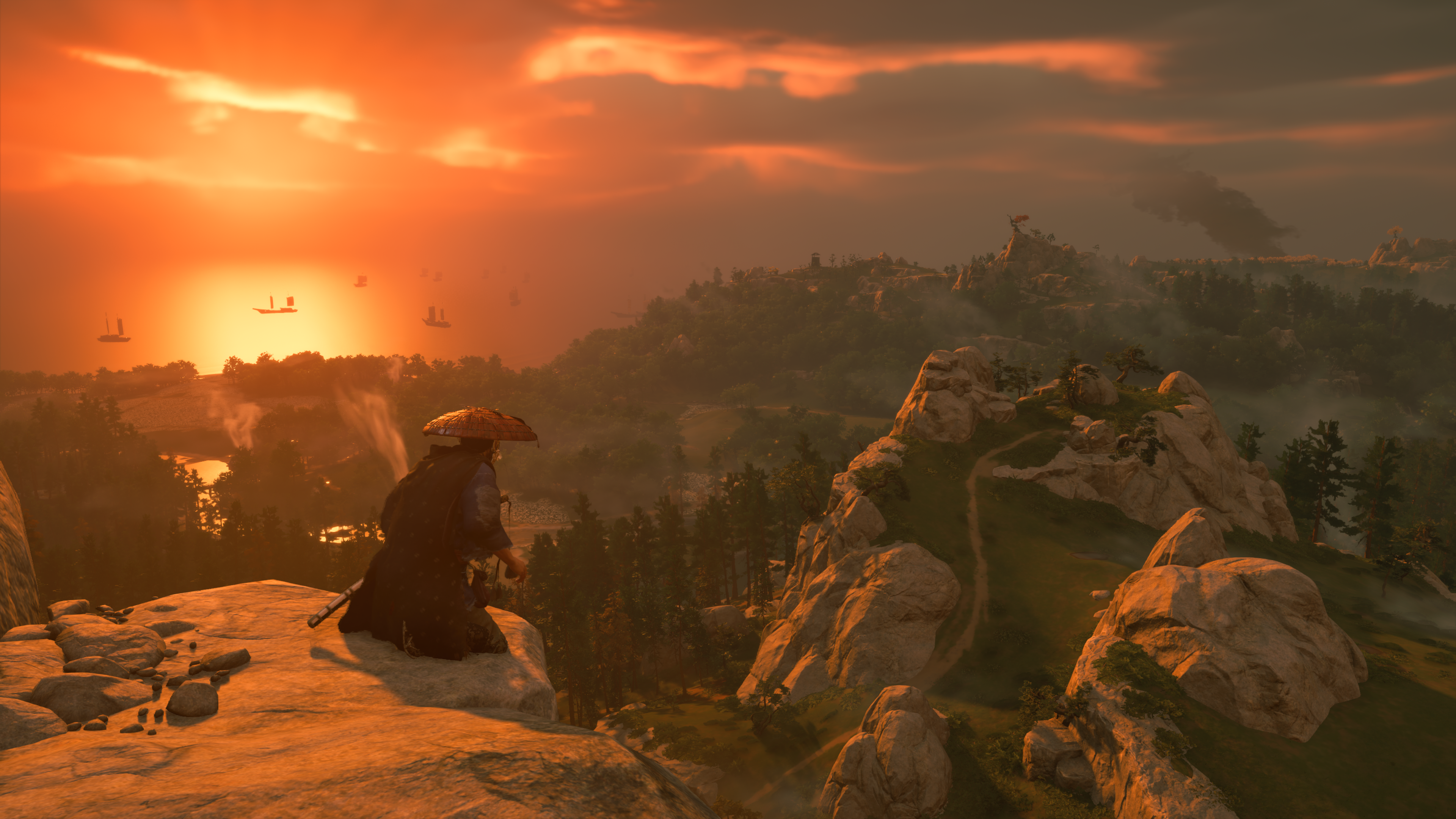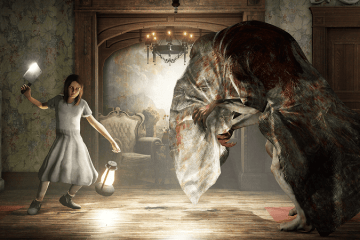
Cliché: a phrase or opinion that is overused and betrays a lack of original thought. Kind of a harsh way to start my Ghost of Tsushima review, I know. The unfortunate reality is that the new Sucker Punch Productions game doesn’t break much new ground. That’s not to say that it’s a terrible experience, actually far from it. During my 50+ hour journey with Jin Sakai, GoT’s protagonist, I had more fun playing a video game than I’ve had in a really long time. Now let me dig myself out of this hole.
Fresh off the heels of The Last of Us 2 (hey, another cliché), Sony comes out swinging (not a cliché, but a totally intended pun) with it’s newest exclusive release. Known most famously for their work on the Infamous series, Sucker Punch has released its first game in six years. After a short delay due to current world affairs, we finally got our hands on what is an amalgam of several different genres and games. Part open world action game, part combat simulator, a little For Honor and a lot of Assassin’s Creed. Throw it in the oven and out pops Ghost of Tsushima. And let me say, it tastes delicious.

Set in 13th century Japan, we follow Jin on his quest to repel an invading Mongolian army. After the opening battle, he sets out to rescue his uncle who was taken captive during the fight. What follows is a mixture of recruiting allies, acquiring weapons/armors, and leveling up your very wide array of skills. Playing through the main story and doing a few of the side quests would probably take around 30 hours or so. However, completionists will be closer to the 50 hour mark. There are a ton of different collectibles if you’re into that sort of thing. You’ll also be collecting several different materials used to upgrade your gear and depending on the route you choose, it could be a ton! If this all sounds “Ubisofty” so far, you are 100% correct. For those people who enjoy those types of games, Ghost of Tsushima will feel like a warm, familiar pair of underwear that fits your playstyle perfectly. On the surface, that’s what it is. If you dig a little deeper, however, there’s far more to it.
In large open world games, sometimes the story takes a backseat to the tedium of exploring the map. Thankfully, this isn’t the case here. In fact, the exploring aspect of the game is so well done, you’ll forget what you’re doing sometimes. When I say “sometimes” what I really mean is constantly. You might be on your way to rescue some villagers from certain peril and then, “Hey, is that a fox?”. Or you’ll be riding to upgrade your latest armor set and then “Hey, I’m going to write a sweet haiku!”. Pillars of honor (cosmetic items), lighthouses, hot springs (meditate and see Jin’s butt), shrines, there is no shortage of stuff to do. I would be remiss not to mention the bamboo strike challenges as well. They’re basically a button pressing mini game that will boost your resolve which acts as your action points/healing ability. I got overly excited whenever I stumbled upon one of these tests of skill and all of these events happen organically while you play. While you can set waypoints and objectives on your map, the game uses the wind to navigate you to your next locale. As it blows through the branches or tall grass, it guides you flawlessly from point to point. Jump on your horse and ride like, well, the wind to your next destination. It’s super accessible and very unique. Gone are the days of arrows and dotted lines showing your path. Instead, it creates an incredibly immersive experience.

I’m going to try to avoid story spoilers, so this section will be a bit short. I’m just coming off my Last of Us 2 playthrough which, to put it bluntly, was rough as hell. It was trying to invoke specific feelings in the player. Ghost of Tsushima is not that. It is, however, very well written and has excellent pacing. Side missions, of which there are around 60, carry weight. About half of those missions are with one of five companions and those are spread throughout the three acts. Throughout the game you are building relationships with these people. These missions aren’t very long, but they pack a punch at times. You also have the opportunity to take on various strongholds and outposts during your adventure. They open up the fog of war a bit when you complete them which is huge if you’re all about exploring. Finally, there are seven Mythic Tales that reward you special equipment or skills. Or you can skip everything and plow through just the main story. I did all of the missions as they became available so I can’t speak on whether or not it makes a difference during the battles that take place at the end of each act. Regardless, most missions only add depth to the journey. There’s maybe a bit of filler here and there, but not much. In a generally depressing time in the world today, it’s not a heavy handed, hit you in the feels type of game which is much appreciated.
Along your journey, you’ll be treated to some of the deepest, yet easily accessible, combat in games today. When using your katana, there are four different stances that you unlock during your playthrough. Each one corresponds with a different enemy type you’ll face. It’s very similar to For Honor except switching seems much faster. It has to be. There are times that you’ll switch multiple times during one scene. As a champion for easy modes in games, I can comfortably say that it just works. I didn’t have to “Dan” down the difficulty once. You’re also provided with two bows to take out targets that may be out of reach or that one archer that crapped his pants and is running away in terror. You also have access to several gadgets and several different types of armor as well, most of which are upgradable and can provide different bonuses. Going into a large battle? Switch to your Samurai gear. Trying to sneak in undetected? The Ronin outfit is a great choice. There’s even an outfit for people on the hunt for collectibles that makes your controller vibrate when you’re near an item. I found myself switching back and forth all the time. The combat mechanics were my absolute favorite part of the game. It’s incredibly smooth and visceral. You feel like what I imagine a Samurai would feel like. I’ve never lived in 13th century Japan and have never been a Samurai, but I stand by this statement. Moving on.

As you roam the world, you’ll have random encounters with small bands of Mongols. You have the option of entering Stand-Off mode. It’s more a test of reaction time than anything else, but when you win, the feeling is amazing. They become harder as you progress and certain enemies are harder than others (I’m looking at you Straw Hat Ronin), but it’s a fun mechanic. In the end though, they pale in comparison to the duels. There are around 25 or so spread throughout the game. To do them all you’ll have to delve into the side missions a bit. These are more or less your boss battles. No gadgets, no tricks, just steel on steel katana slashing goodness. A small cinematic begins every duel and with a flick of your sword, it’s on. These were far and away my favorite part of the game. These fights will put your skills to the test and that feeling of victory is unmatched when compared to the rest of the game.
Don’t feel like hacking your way through the droves of invaders? Good news. A large part of the overall narrative is Jin moving away from the path of the Samurai towards something less honorable. That’s not a spoiler. The game isn’t called Samurai of Tsushima. The stealth mechanics are done well, but will add a bit of length if you choose to use that style of gameplay. It also becomes a little overpowered at times (more on that below). The beauty of the game is that aside from a few missions, you can tackle most situations as you see fit. You’re never really locked in to doing only stealth, though I did rely on it heavily early on. Once you get the poison blow dart, smaller outposts become a breeze. And it’s hilarious watching your enemies beat the crap out of each other.
Graphically, the game is gorgeous, most of the time. You have the option of performance or resolution mode. Turns out, there’s not a huge difference in frame rate between the two modes. The use of lighting is top notch and the world is extremely vibrant and colorful. The photo mode is second to none as well. You can take your regular, run of the mill screenshots with all the options that you would normally see. You can also take moving pictures, utilizing different particle effects and the aforementioned wind to make some really cool captures. There’s also a beautiful black and white mode named after the famous filmmaker Akira Kurosawa. While not for me, I played a few hours in it and it’s stunning. Just having it as an option is fantastic. I’m probably going to go back and do an entire playthrough in this mode. It’s not always sunshine and roses though. While most of the game looks amazing, there are times when it looks like you’re playing on a PlayStation 3. Cutscenes are generally fantastic, but at times during gameplay, it just craps the bed. There’s no other way to put it. There isn’t a specific time when it happens either. You’ll be riding through the forest with rays of sunlight breaking through the branches, then you break into an open area and I’m back in 2008. It doesn’t happen enough to ruin the game or break the immersion, it’s just annoying.


Let’s talk about the camera for a minute. It sucks. There were numerous times where I had my killstreak interrupted because I couldn’t see through a tree or a building. You can control it with your right thumbstick but it’s incredibly slow. When you have a game where combat is based on speed and reaction time, having to worry about a bad camera can be catastrophic. A lot of this could be helped with a lock on option, something that has almost become standard in this type of game. Do you get used to it? To an extent, but even when you think you have mastered it, oops, a tree. Frustrating.
While I thoroughly enjoyed the combat, there comes a point in the game where it becomes almost too easy and a bit repetitive. It basically comes down to a combination of upgrades that can make you nearly invincible and incredibly powerful. While the enemies do get a bit tougher, they don’t present much of a challenge to a fully upgraded and tricked out ghost. When you unlock the dart gun, you can pretty much run wild on most of your opponents, from the safety of the tall pampas grass of course. By the end of the game I stopped relying on stealth entirely and ran head on into the fray. It was much faster and honestly a bit more fun by that point, especially given all of the new skills you unlock later in the game.
A few other notes. On several occasions ammo and items would seemingly just disappear out of my inventory. No idea why and it was super random. I would roll up to a group of enemies, grab my bow and be out of arrows. Can’t explain it, just super frustrating. Some of the traversal/parkour aspects are just plain broken. If you thought the Mongols were bad, wait until you face off with a ladder. I challenge you to find a tougher enemy in the game. Ladders man. Ladders. There were also a few times where I needed to crawl through some tight spaces and got stuck. Now before you start in with the fat jokes, just know that it’s a known issue and has nothing to do with my girth. Reloading your last checkpoint fixes the problem. I’d have to reload a checkpoint in 1994 to fix mine.

I’m not going to lie, despite its shortcomings, Ghost of Tsushima is my personal game of the year at this point. There’s still more to explore that I haven’t even touched on in this article. That’s mostly because we would be entering spoiler territory and also I can’t even remember what I had for breakfast most days, but I digress. I don’t play games to get kicked in the feels. I play because it’s fun. Ghost of Tsushima is fun. I can’t just ignore the shortcomings unfortunately. It borrows heavily from other games, the camera is a hot mess, and the combat becomes a bit too easy later in the game. Nevertheless, I did thoroughly enjoy my time with the game. More than I expected to. And while it may sound cliché…you know what? Nevermind. Just go play.
Final Verdict : 8.5
Fun Factor : 9
Technical Prowess : 8
Time Investment : 25-60 hours
Replayability : 7
You can find Seasoned Gaming Reviews on Open Critic here!



[…] of our favorite games of the year. If you haven’t caught up on our review, you can find that here. But today, Developer Sucker Punch announced a new co-op mode will be launching this fall for the […]